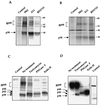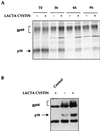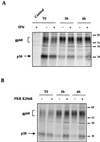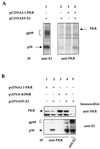Detection of a novel unglycosylated form of hepatitis C virus E2 envelope protein that is located in the cytosol and interacts with PKR
- PMID: 11773402
- PMCID: PMC135859
- DOI: 10.1128/jvi.76.3.1265-1272.2002
Detection of a novel unglycosylated form of hepatitis C virus E2 envelope protein that is located in the cytosol and interacts with PKR
Abstract
The hepatitis C virus (HCV) envelope protein E2 has been shown to accumulate in the lumen of the endoplasmic reticulum (ER) as a properly folded glycoprotein as well as large aggregates of misfolded proteins. In the present study, we have identified an additional unglycosylated species, with an apparent molecular mass of 38 kDa (E2-p38). In contrast to the glycosylated E2, E2-p38 is significantly less stable and is degraded through the proteasome pathway. Correspondingly, E2-p38 is found to be ubiquitinated. E2-p38 is localized mostly in the cytosol, in contrast to the glycosylated form, which is exclusively membrane associated. Alpha interferon (IFN-alpha) treatment or overexpression of the double-stranded RNA-activated protein kinase (PKR) significantly increased the stability of E2-p38, consistent with a previous report (D. R. Taylor, S. T. Shi, P. R. Romano, G. N. Barber, and M. M. Lai, Science 285:107-110, 1999) that E2 interacts with PKR and inhibits its kinase activity. Direct interaction between PKR and E2-p38, but not the glycosylated form of E2, was also observed. These results show that E2-p38 is the form of E2 that interacts with PKR in the cytosol and may contribute to the resistance of HCV to IFN-alpha. Thus, an ER protein can exist in the cytosol as an unglycosylated species and impair cellular functions.
Figures






Similar articles
-
Protein synthesis and endoplasmic reticulum stress can be modulated by the hepatitis C virus envelope protein E2 through the eukaryotic initiation factor 2alpha kinase PERK.J Virol. 2003 Mar;77(6):3578-85. doi: 10.1128/jvi.77.6.3578-3585.2003. J Virol. 2003. PMID: 12610133 Free PMC article.
-
Inhibition of the interferon-inducible protein kinase PKR by HCV E2 protein.Science. 1999 Jul 2;285(5424):107-10. doi: 10.1126/science.285.5424.107. Science. 1999. PMID: 10390359
-
Positional effect of phosphorylation sites 266 and 267 in the cytoplasmic domain of the E2 protein of hepatitis C virus 3a genotype: interferon resistance analysis via sequence alignment.Virol J. 2011 May 5;8:204. doi: 10.1186/1743-422X-8-204. Virol J. 2011. PMID: 21545731 Free PMC article.
-
Repression of the PKR protein kinase by the hepatitis C virus NS5A protein: a potential mechanism of interferon resistance.Clin Diagn Virol. 1998 Jul 15;10(2-3):157-62. doi: 10.1016/s0928-0197(98)00034-8. Clin Diagn Virol. 1998. PMID: 9741641 Review.
-
The ubiquitin-proteasome pathway of intracellular proteolysis.Essays Biochem. 2002;38:51-63. doi: 10.1042/bse0380051. Essays Biochem. 2002. PMID: 12463161 Review.
Cited by
-
Coevolution analysis of Hepatitis C virus genome to identify the structural and functional dependency network of viral proteins.Sci Rep. 2016 May 20;6:26401. doi: 10.1038/srep26401. Sci Rep. 2016. PMID: 27198619 Free PMC article.
-
E6AP ubiquitin ligase mediates ubiquitylation and degradation of hepatitis C virus core protein.J Virol. 2007 Feb;81(3):1174-85. doi: 10.1128/JVI.01684-06. Epub 2006 Nov 15. J Virol. 2007. PMID: 17108031 Free PMC article.
-
The hepatitis C virus persistence: how to evade the immune system?J Biosci. 2003 Apr;28(3):287-304. doi: 10.1007/BF02970148. J Biosci. 2003. PMID: 12734407 Review.
-
Evidence for mixed membrane topology of the newcastle disease virus fusion protein.J Virol. 2003 Feb;77(3):1951-63. doi: 10.1128/jvi.77.3.1951-1963.2003. J Virol. 2003. PMID: 12525629 Free PMC article.
-
MKRN1 induces degradation of West Nile virus capsid protein by functioning as an E3 ligase.J Virol. 2010 Jan;84(1):426-36. doi: 10.1128/JVI.00725-09. J Virol. 2010. PMID: 19846531 Free PMC article.
References
-
- Colombo, M. 1998. The role of hepatitis C virus in hepatocellular carcinoma. Recent Results Cancer Res. 154:337–344. - PubMed
Publication types
MeSH terms
Substances
Grants and funding
LinkOut - more resources
Full Text Sources
Molecular Biology Databases

